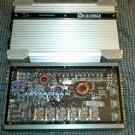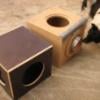Leaderboard
Popular Content
Showing content with the highest reputation on 12/10/2009 in all areas
-
1 pointCrest Factor Before we can discuss amplifier headroom, we first need to discuss the music we are listening to. And the concept we need to understand is that of crest factor. Sine waves are the simplest tone. Sine waves are the "test tones" that many people use in this hobby for various reasons, although most likely familiar to everyone as the source used in the typical SPL competition. Sine waves are a periodic waveform. That is, these sine waves or test tones are quite simply a repeating waveform with equal intervals and amplitude in time. Music, in contrast, is very dynamic and transient. Music is a nonperiodic wave form. Meaning music is composed of sounds that frequently vary amplitude, vary in tone and last for varying periods of time. Most sounds and peaks in music last for very brief periods of time, many times only for a fraction of a second. Both sine waves and music have an "average level" and a "peak level". The peak level is the highest output level achieved by the tone or music. What we are concerned about is the difference between that average level and the peak level. And that difference is known as crest factor. Sine waves have a crest factor of 3db. Meaning the peak of the signal is 3db higher than the average level of the signal. Music on the other hand has a crest factor of 10db - 20db (or more) depending on the dynamics of the music and the amount of compression. On newer music, the compression is (unfortunately) typically higher reducing the dynamics and thus reducing the crest factor to the lower end of that spectrum. Higher quality recordings with less compression will be on the upper end of the crest factor spectrum with a crest factor of around 20db or more. The System Now that we understand a little bit about the music we're listening to, let's discuss how it relates to your system. So what does a crest factor of 10db or 20db mean? Well, we can use the formula 10*log(X/Y) to determine how much of a power increase is required to increase output by 10db and 20db. 10*log(10/1) = 10db 10*log(100/1) = 20db This means the amplifier must increase power by a factor of 10 to increase output by 10db and a factor of 100 to increase output by 20db. In other words, that dynamic peak of 10db will require your amplifier provide 10x the power over the average level. And to meet a 20db dynamic peak, it would require the amplifier output 100x the power over the average level. Sounds like a lot, eh? It is! So if you are using an amplifier with an unclipped power output capability of 100w, and you are listening to music with a crest factor of 20db then the average output you would be able to obtain from the amplifier and avoid clipping the dynamic peaks is 1w. The same amplifier with a crest factor of 10db, the average output would be 10w. What happens if we want to listen to our 20db crest factor music at a higher average level than just 1w of output on our 100w amplifier? Well, you certainly can.....but you will end up clipping the dynamic peaks. Going back to what we said before about the nature of music, it's very transient. Those large peaks will occur over very short durations of time and change rapidly. Due to various reasons our brain can handle some amount of clipping without negative audible effects. But it is also possible, depending on the amount of clipping, original crest factor of the music and frequency regions involved, etc, that this clipping could result in harsh or compressed sounding dynamics at higher output listening levels. This is because of the increase in distortion as a result of clipping, and due to the forced reduction of the level of the dynamic peak compared to the average level of the music. An undesirable result indeed. There are, of course, other issues involved with clipping such as potential damage to components such as speakers, but that's best left to another thread as it can be quite involved in-and-of itself. Headroom This leads us to the utility of amplifier headroom. And also the reason I'm a huge advocate of purchasing the most power your budget will allow. What is meant by the term "headroom"? It means having excess power reserves or capabilities available from the amplifier for use during those dynamic peaks to avoid clipping the amplifier and the resultant negative effects it can have on the sound of the system. The two ways of obtaining this headroom are as follows; The first is "headroom" inherent to the amplifier itself, the second is headroom allowed by purchasing an amplifier with higher power capabilities. For headroom inherent to the amplifier itself, we need to consider the way amplifiers are measured. Amplifiers power rating can be done in several ways. The first, and most commonly cited, is continuous average power (incorrectly called "RMS" power). This should be the output capabilities of the amplifier measured over extended periods of time at some distortion figure, generally 1% or less, at some supply voltage, generally 12V-14.4V. It is, however, possible to measure an amplifiers output on very short periods of time, typically fractions of a second. This is referred to as music power or dynamic power. For most typical amplifier designs, this will not change significantly enough from the continuous power output capabilities to really matter in the grand scheme of things. It is, however, possible to design an amplifier that has considerably higher dynamic power than it does continuous power output capabilities. One more extreme example of this is Rockford's 15kw amplifier with it's enormous bank of internal capacitors that can't sustain long term output support but can greatly increase power output for short term "bursts". Other companies have designed more practical applications of increasing dynamic power, but these are the exception and not the rule. Do not confuse the real measure of dynamic or music power with the fictional marketing term used by many low end companies, which in their lingo is essentially an ILS rating. That leaves use with the second consideration to increasing headroom; Buying an amplifier with higher power capabilities than we may think we need. Looking back at how power increases with regard to dynamic peaks, it's easy to see how this could be beneficial. Compare, for example, a 50w amplifier and a 200w amplifier. Let's just say, to keep things simple, that we are listening to music with a crest factor of 10db and we are listening at an average level that requires 10w of output from the amplifier. When those 10db dynamic peaks occur, they will require a 10x increase in power, to 100w. If we are using a 50w amplifier, then these peaks would require the 50w amplifier to output twice it's unclipped output capabilities.....which means we will be clipping the amplifier during those peaks, potentially leading to the ill effects previously listed. In this particular scenario, you reduced your unclipped dynamic headroom capabilities from the necessary 10db to 7db. On the other hand, if we are using the 200w amplifier and that 10db dynamic peak occurs, we are still well under the amplifier's capabilities....removing the worry about clipping and the resultant increase in distortion and compressed dynamics. Does everyone need a 200+ watt-per-channel amplifier? Certainly not. But it does explain why it makes sense to look for the amplifier with the highest power capabilities out of the viable options within your budget. All else equal (build quality, features, aesthetic value, etc) it's generally advisable to go with the higher powered amplifier. Where it can be avoided, there's no reason to make available power the limiting factor to the performance of your system. Allow yourself the necessary headroom when choosing amplification for your system. If that's a 50wpc amplifier or a 300wpc amplifier is a decision for you to make. Now, you may be thinking; But wait! My speakers are only rated at 50w, what in the heck will happen when they receive that 100w dynamic peak?! Well, the short answer here is that a speaker's power rating is typically a thermal rating based on it's ability to sustain that power level over an extended period of time. Again, due to the transient nature of music, those dynamic peaks are occurring over very short periods of time. Due to the short time frame of that dynamic peak, the speaker will quickly dissipate the heat. Speakers can handle much more power over very short periods of time than they can over longer periods of time.
-
1 pointToday i saved my friend and his system choice. He was talkin about how he was gonna run to "competition" dual 12's. I guided him to ssa and Recommended the Dcon and 187 from IA audio.
-
1 point@ bigrank - Dang, good catch on the SSA store pricing. Pays to shop around. @crazykid - True words. Keep that voltage up and amps will love you long time.
-
1 pointIf you wanted to follow Alpines specs for a box I supposed you could do it. They recommend 1.3ft^3 @ 36hz after all displacements which seems on the small side.
-
1 pointAmusingly you deleted your recommendations after reading my post.... ya i read almost all of it.....missed your post....... then after re-reading it decided you are more then likely right .... mite change the sound alittle, but not get super lounder... so no sense getting a pissing match going when you are right !
-
1 point
-
1 pointThat popping was likely the mid reaching their excursion limit. If so, then increasing the highpass crossover as I suggested could help alleviate part of that issue. Do you know where the highpass is set now? Also make sure you don't have any EQ adjustments in the headunit (if it has any) turned up in level. Sound deadening & sealing the door would help increase their performance also. I would personally try intelligent application of sound deadening and sealing up any holes in the door to fully isolate the frontwave from the backwave prior to purchasing new speakers. For sound deadening, I would highly recommending www.sounddeadenershowdown.com If you have any questions about how many tiles to purchase or the best application/use of the product to obtain full performance from the sound deadening for your money, shoot Don an email and I'm sure he would gladly assist you.
-
1 pointBut dont get me wrong, that amp will do what you want it to do until you get what you need or want so I wouldnt rush to get another amp.
-
1 pointI believe SPY does, or at least I thought it was him. Check the classified section, I believe there is an RL-i 8 for sale and someone mentions they have a gasket.
-
1 point
-
0 points
-
-1 pointsIm lost, what do you mean you want a sub that sounds clean. Have you tried a different box? Your box is too damn big, the biggest it should be is 3.25ft^3. Try a smaller box at the tuning, just my .02.
-
-1 points[ what's the tune of the box to be that you wanted??? according to my figures 4 x 4 inch areo ports would work but if you put to close to gather the bends may be difficult to do if it's a low tune like 30 -31 hz this makes it harder yet cause of length if you need help just say some thing. this was port back sub up talk about a p.i.t.a.
-
-1 pointsI closed this thread. Glad to re-open it if you take the time to write it in a fashion that is legible. Adding question marks in the middle of run-on's does not make a paragraph. Please re-write your first post and I'll put it back in the thread and re-open it.
-
-2 pointsfirst off i am not mister know it all so please bare with i do know a lot but will see . but any ways what is it with resonant tuning frequency? would it be better to tune low as possible for like a t line and get a higher score? unless your talking frequency length. the lower in the octave you got the hard the bass hits right ??? with in reason of course like the sub dropping off and just can't play well at 18 hz were it plays better at 47 Hz etc etc ... because the music energy is reaching the mic at it full potential of 47Hz if you tune to high the spl drops off again so you lose power in the spl right??? so why would you look for a resonant frequency like 18 hertz i thought was a resonant frequency because it resonates the body panels. which is not wanted any thing below 20 hertz really but is wanted because it hits the hardest hence the tuning of the subsonic filter right??? but the only problem i see is frequency length at 20 Hertz being to soft because the box dropped off kinda like a sealed in the graph on winisd were 40-50 hertz and above it is about base line like 1 w/ 1m of spl.and gradually drops off the lower it goes so 20 hertz is 12 db's down of the same sub in a ported box so if you lay the two over each other the ported and the sealed in winisd at 20 Hertz some subs are 12 db's different between the two ported versus sealed . but still frequency length is longest at 20 hertz but tends to drop off some times right because of the box ??? so if it's better to play low why are people looking for high frequency's??? if tuning low is best would this make a t-line best ??? i know t line will play lower in the octave such as 18 hertz and will out put a heck of a lot of db's then a ported for the same sub does. with in respect to that sub because certin sub play best in that certain box right??? kinda like putting a infinite baffle only sub in a ported box why do it ??? so why would you look for a higher resonant frequency is it because you are not reaching the mic??? then box is to far away but has to be behind the "b" pillar of the automobile right for most competitions so that would rule out car's for spl comps right if you wanted to hit a big numbers??? isn't this were planing comes in to effect ???? so why on one of my test tone disks booklets why does it say 67-200 hertz is the best for spl ???? i though 80 hertz and above was for mids/highs lol's i have never seen a sub play 67 and up but thats what the booklet say is for maxium spl is there a reson for this or is it just a typo????







